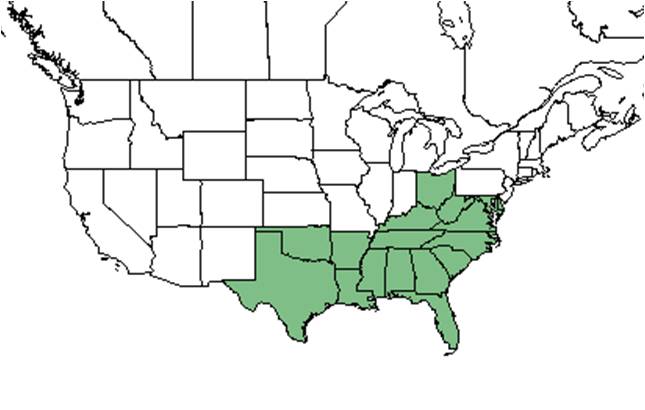Difference between revisions of "Pityopsis graminifolia"
Steve Brewer (talk | contribs) (→References and notes) |
Steve Brewer (talk | contribs) (→Photo Gallery) |
||
| Line 62: | Line 62: | ||
==Cultivation and restoration== | ==Cultivation and restoration== | ||
==Photo Gallery== | ==Photo Gallery== | ||
| + | |||
==References and notes== | ==References and notes== | ||
Revision as of 16:09, 18 August 2015
| Pityopsis graminifolia | |
|---|---|
Error creating thumbnail: Unable to save thumbnail to destination
| |
| Scientific classification | |
| Kingdom: | Plantae |
| Division: | Magnoliophyta - Flowering plants |
| Class: | Magnoliopsida – Dicotyledons |
| Order: | Asterales |
| Family: | Asteraceae |
| Genus: | Pityopsis |
| Species: | P. graminifolia |
| Binomial name | |
| Pityopsis graminifolia (Michx.) Nutt. | |

| |
| Natural range of Pityopsis graminifolia from USDA NRCS Plants Database. | |
Common name: narrowleaf silkgrass
Contents
[hide]Description
A description of Pityopsis graminifolia is provided in The Flora of North America.
Distribution
Ecology
Habitat
Pityopsis graminifolia is restricted to native groundcover with a statistical affinity in upland pinelands of South Georgia (Ostertag and Robertson 2007).
Phenology
Seed dispersal
wind dispersed Steve Brewer[1]
Seed bank and germination
Fire ecology
May or may not show fire-stimulated flowering, depending on variety or ecotype (Brewer 1995; 2009; Gowe and Brewer 2005).
Pollination
The following Hymenoptera families and species were observed visiting flowers of Pityopsis graminifolia at Archbold Biological Station (Deyrup 2015):
Andrenidae: Andrena fulvipennis
Apidae: Bombus impatiens, Epeolus pusillus, Nomada fervida
Colletidae: Colletes mandibularis
Halictidae: Agapostemon splendens, Augochlora pura, Augochlorella aurata, Augochloropsis anonyma, A. metallica, A. sumptuosa, Halictus poeyi, Lasioglossum miniatulus, L. nymphalis, L. pectoralis, L. placidensis
Leucospididae: Leucospis robertsoni
Megachilidae: Anthidiellum notatum rufomaculatum, A. perplexum, Anthidium maculifrons, Coelioxys octodentata, C. sayi, C. texana, Dianthidium floridiense, Megachile albitarsis, M. brevis pseudobrevis, M. georgica, M. inimica, M. mendica, M. petulans, M. pruina
Sphecidae: Bicyrtes capnoptera, Cerceris tolteca, Philanthus ventilabris, Prionyx thomae, Trypargilum clavatum johannis
Vespidae: Parancistrocerus salcularis rufulus, Stenodynerus beameri
Use by animals
Buds fed upon by white-tailed deer (Brewer and Platt 1994).
Diseases and parasites
Conservation and Management
Cultivation and restoration
Photo Gallery
References and notes
Brewer J.S. and Platt W.J. 1994. Effects of fire season and herbivory on reproductive success of a clonal forb, Pityopsis graminifolia. Journal of Ecology 82:665-675.
Brewer J.S. 1995. The relationship between soil fertility and fire-stimulated floral induction in two populations of grass-leaved golden aster, Pityopsis graminifolia. Oikos 74:45-54.
Brewer, J. S. 2009. Geographic variation in flowering responses to fire and season of clipping in a fire-adapted plant. American Midland Naturalist 160:235-249.
Deyrup, M.A. and N.D. 2015. Database of observations of Hymenoptera visitations to flowers of plants on Archbold Biological Station, Florida, USA.
Gowe, A.K. and J. S. Brewer. 2005. The evolution of fire-dependent flowering in goldenasters (Pityopsis spp.). Journal of the Torrey Botanical Society 132:384-400.
Ostertag, T.E., and K.M. Robertson. 2007. A comparison of native versus old-field vegetation in upland pinelands managed with frequent fire, South Georgia, USA. Pages 109–120 in R.E. Masters and K.E.M. Galley (eds.). Proceedings of the 23rd Tall Timbers Fire Ecology Conference: Fire in Grassland and Shrubland Ecosystems.
- Jump up ↑ personal observations